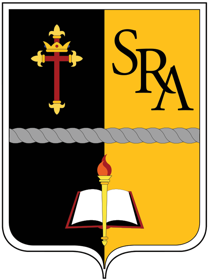Music Ministry/Choir
Purpose: Music Ministry uses music to support and enhance the "proclaiming, praying, and responding to the Word of God" within the liturgy. (United States Conference of Cathollic Bishops, Music and the Proclaimation of God's Word, Catechetical Sunday - September 20, 2009.) At SRA, we learn from each other by inquiring about hymn lyrics or words to get a better understanding of how a song fits the liturgical message for any given Mass.
Who We are: Music Ministry consists of parishioners who enjoy sharing their time and talent by singing, playing instruments, and praising Jesus Christ. Music education varies among members.
What We Do: Music Ministry joyfully gathers to learn and rehearse music for weekend Masses, holiday Masses, and/or Liturgical Services. In addition, Music Ministry supports celebratory Masses for SRA School students, such as First Communion, Confirmation, and Graduation.
Meetings: Music Ministry choir members practice one evening per week, usually on Thursdays. The Musicians practice with the Choir on Thursdays and also on Saturday mornings. Choir members are asked to attend Mass on either Saturday at 4:30pm or Sunday at 9:00am every week. Some choir members attend both. Typically, the musicians attend both weekend Masses. Participation during the summer is TBD.
For more information contact [email protected].
The Wicks Organ Company started in the early 1900's on the second floor of a jewelry and watch-making store in Highland, Illinois. The local Catholic priest had asked John Wick to study organ and become the church organist. Soon the parish wanted a new pipe organ to replace their aging reed organ, so John Wick, with the help of his brothers, Louis and Adolph, started to work. Using their talents as a watchmaker, a cabinet maker, and a jeweler, the three Wicks created a small mechanical action instrument that successfully met the needs of their church.
It wasn't long before nearby churches heard of their work, and wanted the same for their growing parishes. The Wicks created more of their instruments, and interest in organs built right here in Illinois grew. By 1908, the three Wicks incorporated the Wicks Organ Company, and began producing pipe organs for homes and churches in Illinois, Indiana, Missouri, and eventually almost every state in the country.
The Wicks initially used all mechanical action, but with the advent of electricity and electric blowers, began to experiment with electro-pneumatic actions. There are surviving examples of their work today, but John Wick thought that surely an organ could be operated purely electrically, avoiding the difficulties of pneumatic actions. Such pneumatic actions require frequent total releathering, and are susceptible to dirt, air pollution, changes in weather, moisture, and the winding and layout of the organ must be designed with the action in mind, not the pipework, or the amount of space available to the organ. When difficulties do occur in these actions, repair and service can be incredibly difficult.
| Wick’s Organ – 1968 Highland, Illinois 11 Ranks – Opus 4753 2 Manual and Pedal Pipe Organ Manual Compass CC to C4 – 61 notes Pedal Compass CCC to G – 32 notes Console: Draw knob – built to AGO requirements |
|||
| Great (Exposed) 8’ Principal 8’ Bourdon 4’ Octave 4’ Nachthorn 2’ Flachflöte II Mixture (1⅓) (19 & 22) 8’ Trompette (Swell) |
12 Pipes 61 Pipes 61 Pipes 61 Pipes 61 Pipes 61 Pipes |
Transept – Blank (North Wall) Incomplete Chimes – North and South Walls of Sanctuary |
|
| Swell (Expression) 8’ Rohrflöte 8’ Viola 4’ Gemshorn 2 ⅔’ Nasat 2’ Blockflöte 8’ Trompette Tremolo |
61 Pipes 61 Pipes 61 Pipes 61 Pipes 24 Pipes 61 Pipes |
Pedal 16’ Spitzprincipal 16’ Lieblich Gedeckt 8’ Spitzprincipal 8’ Gedeckt (Great) 4’ Choral Bass 2’ Hohlflöte (Great) 16’ Posuane 8’ Trompette (Swell) 4’ Clarion (Swell) |
12 Pipes 12 Pipes 32 Pipes 12 Pipes 12 Pipes |
| Couplers Great to Great 4’ Great to Pedal Swell to Pedal Swell to Great 16’ Swell to Great 8’ Swell to Great 4’ |
Swell to Swell 16’ Swell Union Swell to Swell 4’ Transept to Great Transept to Swell Transept to Pedala |
||
| Combination Pistons Four General Pistons General Cancel |
|||
